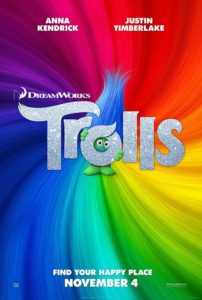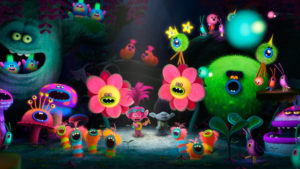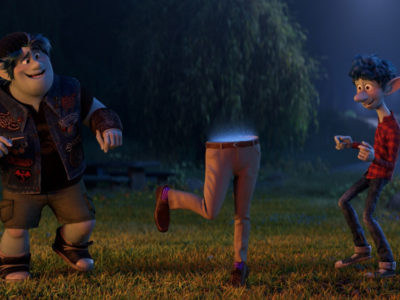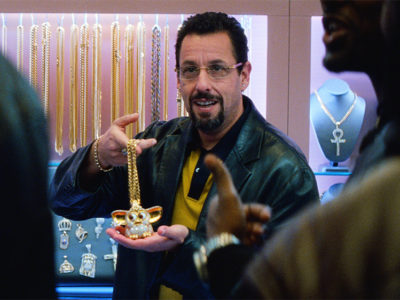Review| Trolls and Joyful Exuberance
 Retro is now the cool, marketable, and profitable thing to do in kid’s movies. Not only have we been subject to countless reboots of classic franchises in the adult genre–so we share it with our kids and create a whole new generation of consumers–but we even have to endure Disney endlessly rebooting classics into live-action and an unending stream of older 80’s and 90’s properties being updated and recast. All seemingly done for bottom lines by studio heads. Trolls is no exception to this reboot-crazed phenomena. However, Dreamworks choice of a property to reboot/reinvigorate is a double-edged sword or, more appropriately, kitchen knife, if such a thing exists. It is both innocuous to the storytelling and integral to its imaginative source material which ends up creating boundless opportunities to innovate and create but produces a rather tepid narrative backbone and sparse thematic substance.
Retro is now the cool, marketable, and profitable thing to do in kid’s movies. Not only have we been subject to countless reboots of classic franchises in the adult genre–so we share it with our kids and create a whole new generation of consumers–but we even have to endure Disney endlessly rebooting classics into live-action and an unending stream of older 80’s and 90’s properties being updated and recast. All seemingly done for bottom lines by studio heads. Trolls is no exception to this reboot-crazed phenomena. However, Dreamworks choice of a property to reboot/reinvigorate is a double-edged sword or, more appropriately, kitchen knife, if such a thing exists. It is both innocuous to the storytelling and integral to its imaginative source material which ends up creating boundless opportunities to innovate and create but produces a rather tepid narrative backbone and sparse thematic substance.
Trolls takes those cute/ugly toys from the 90’s, which were already a reboot of the 1960’s original, classic toy developed in Denmark by Danish woodcutter Thomas Dam, called Dam Dolls *chuckle* which he based off the trolls of Scandinavian folklore. Extremely simplistic in its plot, it stars Anna Kendrick as Princess Poppy, the plucky, young daughter of the king of the trolls, King Peppy (Jeffrey Tambor). The trolls are a culture of song and dance and Poppy surrounds herself with a crew of the best and most musical trolls including trolls voiced by Ron Funches, Gwen Stefani, Russel Brand, and James Corden, as well as oddities like Guy Diamond, a silver-sparkle covered troll who shoots glitter when he breaks wind and was a highlight for my kids and every child in the theater. Of course, there is the outcast, grumpy troll, Branch, played by Justin Timberlake, who is a bit of a doomsday prepper-type. He is convinced the Bergen, a malicious group of troll-like beings who eat the little, bushy-haired wood creatures, will find their group who have been hiding from the Bergen since King Peppy led the group to safety fifteen years prior.
In a seemingly odd twist for Hollywood, which has proven true in other recent movies, the doomsday prepper ‘s paranoia proves justified and the enclave is attacked by the former head chef of the Bergen played by Christine Baranski (known for her role as Diane Lockhart on The Good Wife). This leads to all of Poppy’s closest friends being kidnapped and her setting out on an adventure, with the reluctant help of Branch, to rescue her friends. Along the way, they sing songs, use their bushy hair to fend off giant spiders, and toe-tap their way into Bergen Town in order to rescue their friends before they are eaten by King Gristle (Christopher Mintz-Plasse). It’s a run-of-the-mill quest-type narrative which is not all that great, minus the tons of fun you have while they travel and the original, stunning visuals.
 The aesthetic of Trolls fits a retro mishmash of disco–the music has a strong 70’s groove to it–and EDM that attacks with bright colors, acute angles, and interesting, fun creatures. The pop songs chosen in the movie at times feel somewhat dated, but they chose a good array of memorable tunes you are surprised how many you can remember a week later. One particular musical number with Poppy dazzles as she sets out on her journey through the forest. She falls through multi-colored treetops, avoids insane, kaleidoscopic, furry monsters, and has so much fun she is oblivious to danger. Her cheery optimism to the dangers lying in front of her is a fitting parallel to the meta-reality of Trolls. With a seemingly bland story and a gaggle of one-dimensional characters, this movie does not have a lot going for it. However, it is so much fun! It explodes with exuberance and never tries to take itself too seriously until the very last moments of the movie. In fact, the final scene where the “moral” of the movie resides feels so tacked on and forgettable, but you just don’t care.
The aesthetic of Trolls fits a retro mishmash of disco–the music has a strong 70’s groove to it–and EDM that attacks with bright colors, acute angles, and interesting, fun creatures. The pop songs chosen in the movie at times feel somewhat dated, but they chose a good array of memorable tunes you are surprised how many you can remember a week later. One particular musical number with Poppy dazzles as she sets out on her journey through the forest. She falls through multi-colored treetops, avoids insane, kaleidoscopic, furry monsters, and has so much fun she is oblivious to danger. Her cheery optimism to the dangers lying in front of her is a fitting parallel to the meta-reality of Trolls. With a seemingly bland story and a gaggle of one-dimensional characters, this movie does not have a lot going for it. However, it is so much fun! It explodes with exuberance and never tries to take itself too seriously until the very last moments of the movie. In fact, the final scene where the “moral” of the movie resides feels so tacked on and forgettable, but you just don’t care.
It’s this infectious, joyful exuberance that sticks with you after the conclusion of the movie. It could so easily have gone off the rails and felt as pointless and cash-grab heavy as Angry Birds or Minions, but Dreamworks managed to craft something unique by fusing bright, imaginative visuals with a sense of joyousness. If anything, what resonates deeper than the movie’s message to “find your happy place” is a sense of joyful creativity and exuberance in expressing yourself through music, which inherently is born out of a person’s body and mind. The movie posits happiness is inside us and to a certain extent, is a truthful statement. If it is true the image of God is a part of our created being, then some measure of our happiness can be derived from expressing ourselves as God made us. And although the message of Trolls is not inherently theological, which makes it troubling in a morally relativistic framework, it expresses the God-given desire inside all of us to show off His creative beauty in expressive, unique means. When we do so, we will have a joyful exuberance called worship. While the filmmakers may not have had this in mind during production, Trolls has the imprint of animators and musicians who are reflecting the creative joy the Godhead exuded when creating our world.






